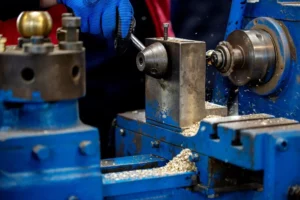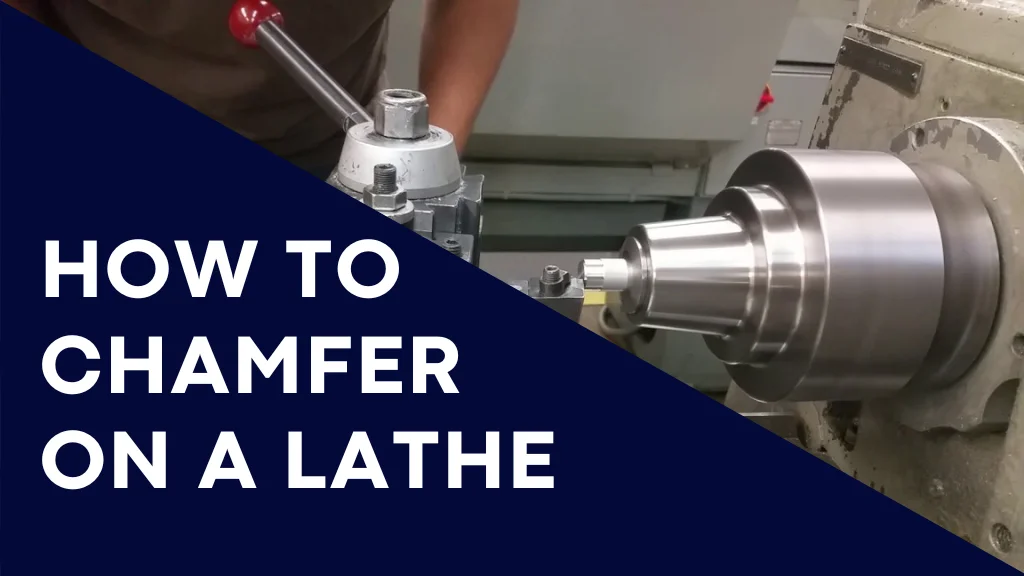The cut is generally made at an angle, and the performing face is known as a chamfer. How to chamfer on a lathe tool ensure you are wearing applicable safety gear, including safety specs and hearing protection.
How is chamfering done?
Also known as beveling or seaming milling, chamfering is the process of cutting away a small portion of material from the edge of a workpiece. The cut is generally made at an angle, and the performing face is known as a chamfer.
How to chamfer on a lathe tool

Before you start, How to chamfer on a lathe tool ensure you’re wearing applicable safety gear, including safety spectacles and hearing protection. Lathe work can produce flying chips and noise.
Step 1: Mount Your Workpiece
Secure the workpiece in the lathe chuck or collet, making sure it’s centered and secured tightly. ensure that the workpiece is duly aligned with the lathes’ spindle axis.
Step 2: Set the Lathe Speed
Determine the applicable lathe speed for your material and the chamfering tool you are using. Faster pets are generally used for lower compasses and softer accouterments, while slower pets are preferred for larger workpieces or harder accouterments. So Consult your lathe’s primer or use assiduity guidelines for speed recommendations.
Step 3: Choose the Chamfering Tool
Select the applicable chamfering tool based on the requested angle and material. Chamfering tools generally come in colorful shapes and angles. Common options include
- The chamfering tool has a 45-degree angle for standard chamfers.
- A deburring tool for removing sharp edges.
- Custom chamfering tool for specific angles or designs.
Step 4: Position the Chamfering Tool
Mount the seaming tool in the lathe tool post or tool holder. ensure it’s securely fastened and duly aligned.
Step 5: Set the Chamfering Depth
Determine the depth of the chamfer you want to achieve and acclimate the tool’s position consequently. You can use the lathes cross-slide or emulsion rest to control the tool’s approach to the workpiece.
Step 6: Start the Lathe
Turn on the lathe and ensure that the spindle is rotating at the chosen speed.
Step 7: Feed the Tool into the Workpiece
Precisely bring the chamfering tool into contact with the workpiece. Make sure the tool’s edge comes into contact with the material gently. You can start by touching off or smoothly scoring the workpiece to gauge the depth.
Step 8: Chamfer the Workpiece
sluggishly feed the tool into the workpiece while keeping a steady hand. The depth and angle of the chamfer will be determined by the tool’s figure, the tool’s positioning, and the rate of feed.
Step 9: Examiner Progress
Continuously observe the chamfering process. Stop periodically to check the chamfer’s depth and quality. Acclimate the tool’s position and feed rate as demanded to achieve the asked chamfer.
Step 10: Finish and Remove the Chamfered Workpiece
Once the chamfer is to your satisfaction, repudiate the chamfering tool and stop the lathe. Precisely remove the grazed workpiece from the chuck or collet.
The Advantages of Chamfer

- Precluding the confirmation of churrs on the edge of a workpiece.
- Chamfer milling is a great way to add a redundant sub-caste of protection to your workpiece, and it can also help to ameliorate the appearance of your finished product.
- Chamfering can also help to reduce the threat of the workpiece being damaged during running or machining. perfecting the general appearance of the edge of a workpiece.
- Reducing the quantity of material that needs to be removed from the edge of a workpiece. Adding the severity of a workpiece helps to give further support for the edge of a workpiece during use.
How to chamfer Milling on a lathe Tools
So Chamfer milling tools generally correspond to a slicing blade that’s mounted on a spindle.
- So there are some of the most essential chamfer knives all machinists should have Chamfer manufacturers’ are one of the oldest and most popular types of mulling knives. The most common type of chamfer manufacturers is the corner chamfer manufacturers, which are used to produce a chamfer on the corner of a workpiece.
- Face manufactories are used to bevel the edges of a workpiece. They can be used to produce a variety of different chamfer sizes and shapes. Face manufacturers generally have two or more slice blades that rotate in a common direction. However, or when you need to produce a veritably wide chamfer, using a face shop is the stylish way to go, If you need to remove a lot of material snappily.
- So, Edge knives are a type of aphorism used to cut straight, clean lines in wood or other accoutrements.
- The end shop Chamfering with end manufactories can be a quick and easy way to deburr or enlarge the opening of a workpiece. When sewing with an end shop, the knife should be rotated at a slow speed and fed into the workpiece at a moderate rate.
Tips for Getting Stylish Results with Chamfer
- When using a Chamfer Mill, it’s important to keep many effects in mind to get stylish results.
- The Chamfer Mill should be kept as vertical to the workpiece as possible.
- The speed of the Chamfer Mill should be kept slow enough so that the cutting edge doesn’t heat and beget damage to the workpiece.
- The Chamfer Mill shouldn’t be provoked too much during use.
- The end shop shouldn’t be broken or based on a point. Using slow pets will help the slicing edge from overheating.
- When toothed knives are used for a chamfer, it’s imperative that the design of the knife not be damaged by the use of too important slice pressure.
- Grazed edges are frequently left untreated, leaving them looking raw and unfinished.
- However, face finish is crucial if you are looking for better results when seaming edges.
- That’s a face finishing specialist furnishing high-quality services for all factors, regardless of their machining system.
Conclusion
How to chamfer on a lathe tool ensure you’re wearing applicable safety gear, including safety spectacles and hearing protection. So Face manufactories are used to bevel the edges of a workpiece. They can be used to produce a variety of different chamfer sizes and shapes. So Edge knives are a type of aphorism used to cut straight, clean lines in wood or other accouterments.
FAQ’s
What’s the purpose of seam welding on a workpiece?
Chamfering is done to enhance safety, aesthetics, fit, and assembly, as well as to remove churrs and sharp edges.
How do I determine the applicable chamfer angle for my operation?
Choose the chamfer angle grounded on design conditions, with 45 degrees being protean, 60 degrees for aesthetics, and custom angles for specific requirements.




